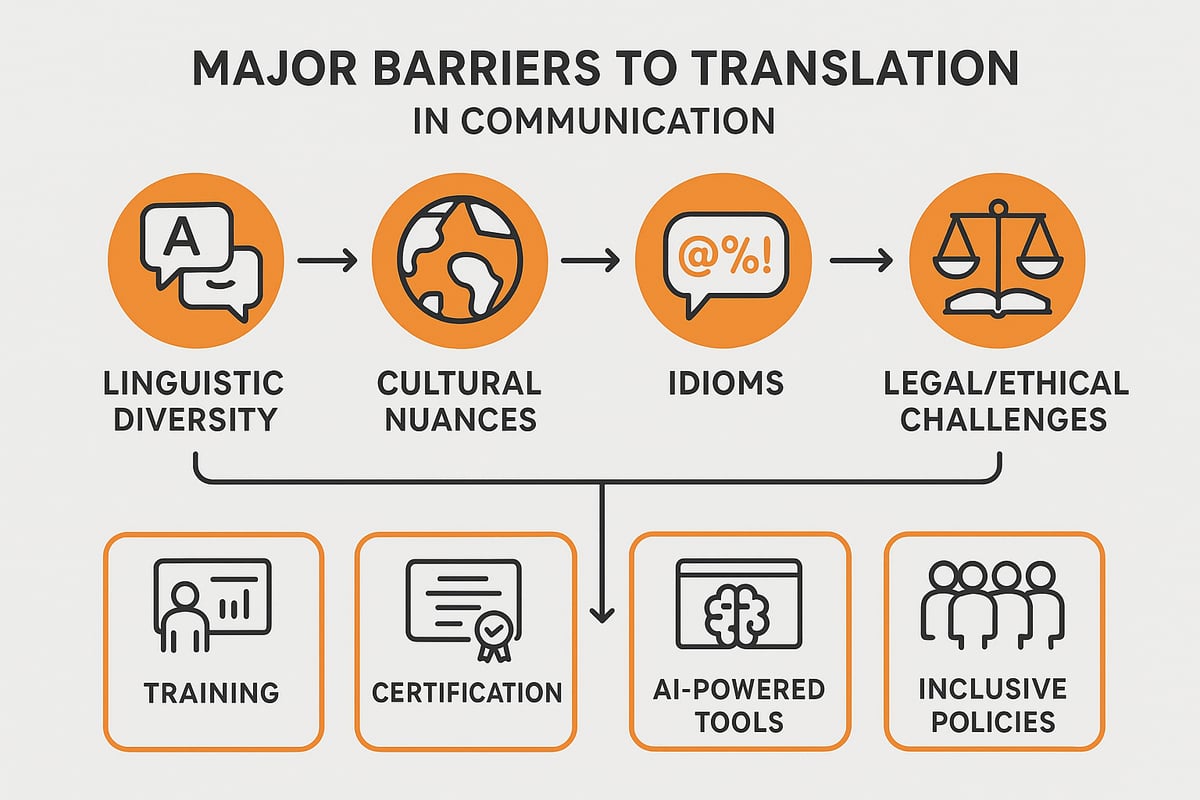In emergency situations, every second counts. Effective communication between dispatchers and...
Language Access Guide: Essential Insights for 2025
In a world where more than 67 million U.S. residents speak a language other than English at home, bridging communication gaps has never been more important.
As 2025 draws near, shifting demographics and new regulations are changing how organizations must approach inclusion and service delivery.
This guide empowers you to master legal requirements, adopt best practices, and harness technology, ensuring everyone receives equitable support.
You will find essential insights, practical steps, and innovative strategies to help your organization stay compliant and inclusive.
Explore a comprehensive overview of language access, covering legal frameworks, compliance steps, technology solutions, best practices, and the latest trends shaping 2025.
Understanding Language Access: Definitions and Importance
Language access is a cornerstone of equitable service delivery in the United States. It ensures that individuals with limited English proficiency, often referred to as LEP, can understand and participate fully in essential services. This concept is rooted in the idea of “meaningful access,” as defined by Title VI of the Civil Rights Act of 1964 and reinforced by Executive Order 13166. Meaningful access means that language is not a barrier to understanding or using services like emergency response, healthcare, education, or government programs.
Both oral and written language access are critical. Oral access involves interpretation during conversations or emergencies, while written access includes the translation of vital documents, forms, and public information. By prioritizing language access, organizations support public safety, compliance, and fairness for all.
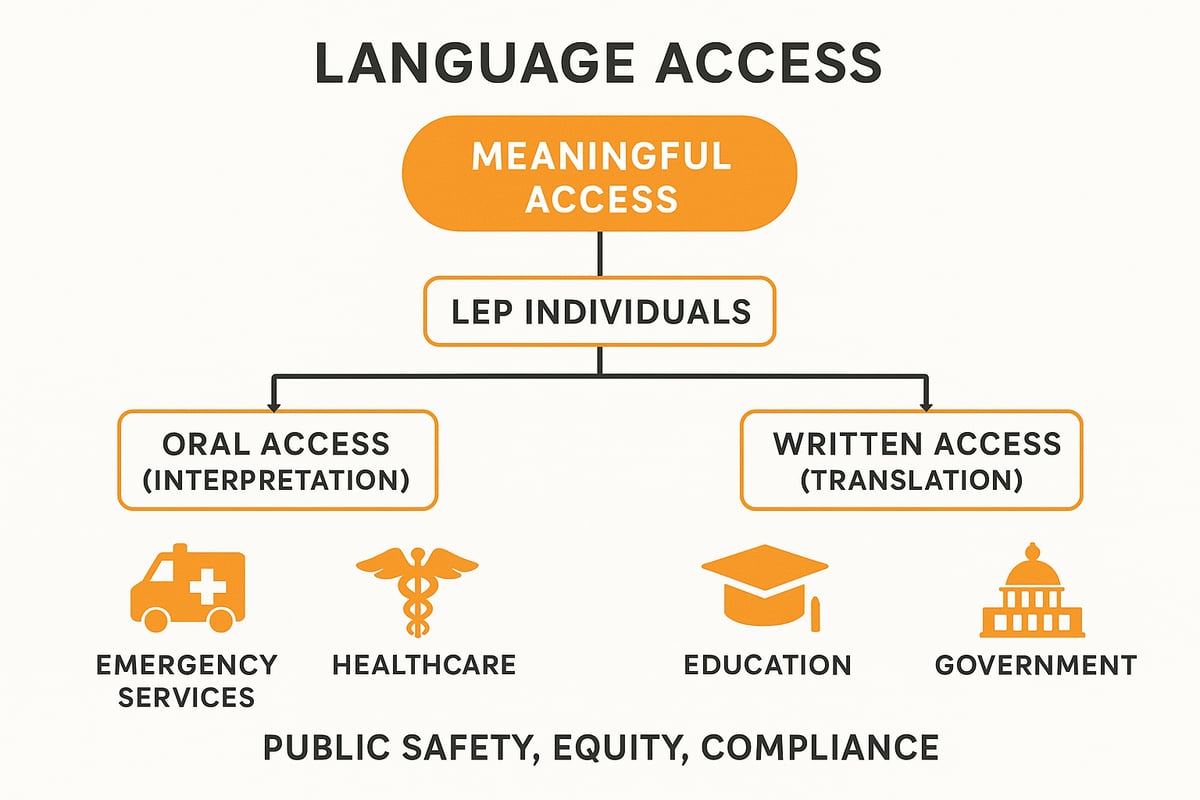
What Is Language Access?
Language access refers to the set of policies and practices that enable LEP individuals to receive and understand information in a language they know well. Under federal law, particularly Title VI and Executive Order 13166, organizations that receive federal funding must ensure meaningful access to their services. This includes providing interpretation for spoken interactions and translation for written materials.
For example, a hospital offering emergency care must provide interpreters for patients who do not speak English and translate discharge instructions into frequently spoken languages. Similarly, schools must send critical notices home in the languages spoken by parents. Distinguishing between oral and written language access helps organizations choose the right approach for each situation. Ultimately, effective language access protects public safety, promotes equity, and helps organizations stay compliant.
Why Language Access Matters in 2025
Linguistic diversity in the United States is at an all-time high. According to recent data, more than 25 million people are considered LEP, and over 500 languages are spoken at home. This diversity has a direct impact on public health, emergency response, and civic participation.
When language access is lacking, real-world consequences can be severe. For instance, delays in emergency services due to language barriers can lead to slower response times and poorer outcomes. In fact, some 911 centers report 5 to 10 minute delays while arranging language assistance. These issues highlight the societal and ethical need for inclusion. For a deeper look into these challenges and their impact, see Language Access in Emergency Services.
Key Stakeholders and Beneficiaries
Many organizations play a role in language access, including federal, state, and local agencies, hospitals, schools, and emergency services. The individuals who benefit are primarily LEP populations, immigrants, refugees, and indigenous language speakers. Community-wide benefits include improved trust, better engagement, and stronger outcomes.
Some key examples are the Department of Homeland Security, Federal Emergency Management Agency, and local governments, all of which have dedicated language access plans. Stakeholders are responsible for ensuring that information is accessible, responding to community needs, and supporting an inclusive environment.
Common Challenges in Language Access
Organizations face several challenges when implementing language access programs:
- Identifying the language needs of diverse populations
- Managing resource constraints, such as staffing, funding, and technology
- Ensuring accuracy and timeliness in translation and interpretation
- Navigating cultural nuances and sensitivities
Recent reports from the Department of Homeland Security and Department of Justice highlight these persistent issues. Overcoming them requires ongoing assessment, investment in professional services, and active community engagement to ensure that language access is both effective and equitable.
Legal Frameworks and Compliance Requirements for 2025
Understanding the legal frameworks guiding language access is essential for organizations serving diverse communities in 2025. Compliance is not only a legal obligation but a foundational element of equity and public trust. Federal, state, and local rules continue to evolve, setting clear expectations for how agencies must address the needs of individuals with limited English proficiency.
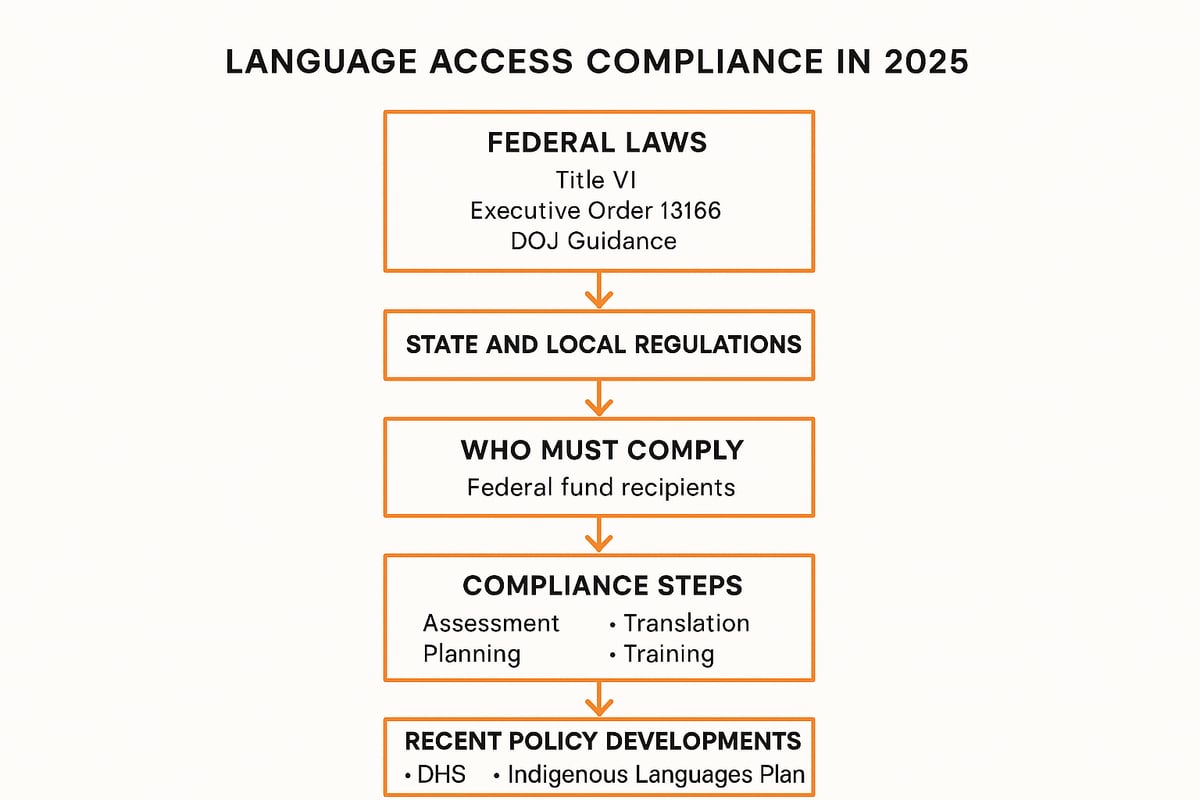
Federal Laws and Executive Orders
At the federal level, language access obligations stem primarily from Title VI of the Civil Rights Act of 1964. This law prohibits discrimination based on national origin, which includes language barriers for limited English proficient (LEP) individuals. Executive Order 13166 further requires all federal agencies and recipients of federal funding to ensure meaningful access for LEP populations. The Department of Justice (DOJ) provides detailed guidance, including best practices and compliance resources. Recent updates, such as the 2023 Attorney General’s memorandum, reinforce the expectation that language access is a civil right, and these requirements apply to all recipients of federal funds.
State and Local Regulations
State and municipal governments often enact their own language access laws, which may be more stringent than federal requirements. These regulations can vary widely by jurisdiction, creating a complex compliance landscape for organizations operating in multiple regions. For example, some cities and states require translation of additional documents or mandate services in more languages than federal law. Case studies, like those highlighted in the Migration Policy Institute’s Language Portal, demonstrate how local plans can supplement federal obligations. Organizations must understand both the minimum federal standards and any enhanced local rules to ensure full compliance.
Who Must Comply?
The mandate to provide language access extends to any organization or agency receiving federal funding, whether directly or indirectly. This includes schools, hospitals, emergency management agencies, and social services. Importantly, compliance is required for entire programs or activities, not just the parts funded by federal money. Failure to meet language access obligations can result in serious consequences, such as loss of funding or legal action. Agencies must stay vigilant and proactive in meeting these requirements to protect both their communities and their operational stability.
What Constitutes Compliance?
Compliance with language access requirements involves taking reasonable steps to ensure LEP individuals have meaningful and timely access to services. This includes conducting needs assessments, mapping the languages spoken in the service area, and differentiating between vital and non-vital documents for translation. Services must be provided at no cost to LEP individuals, and organizations should utilize self-assessment and planning tools such as the DOJ Language Access Plan to guide their strategies. Meeting standards for accuracy, timeliness, and effectiveness is crucial for true compliance.
Key Compliance Steps for 2025
Organizations should follow a structured approach to language access compliance. Start by analyzing LEP population data using sources like the Census and American Community Survey. Develop and regularly update a comprehensive language access plan that covers both written and oral communication needs. Translate all vital documents and provide interpretation services as required. Invest in staff training and capacity-building to ensure protocols are followed consistently. Ongoing monitoring, evaluation, and transparent reporting are essential for continuous improvement and accountability in language access efforts.
Recent Policy Developments and Trends
Recent years have brought significant policy developments impacting language access. The Department of Homeland Security updated its Language Access Plan in 2023, and the 2024 Indigenous Languages Plan aims to address the needs of indigenous migrant communities. Large agencies now implement component-specific plans, and there is a growing emphasis on leveraging technology and stakeholder feedback. With anticipated regulatory updates for 2025, organizations must remain adaptable and informed. Staying ahead of these trends is vital for effective, compliant language access programs.
Implementing Effective Language Access: A Step-by-Step Guide
Ensuring equitable language access requires a clear, methodical approach. Organizations must follow a series of practical steps to build effective systems, remain compliant, and meet the needs of diverse communities. This guide breaks down each step, offering actionable insights and best practices.
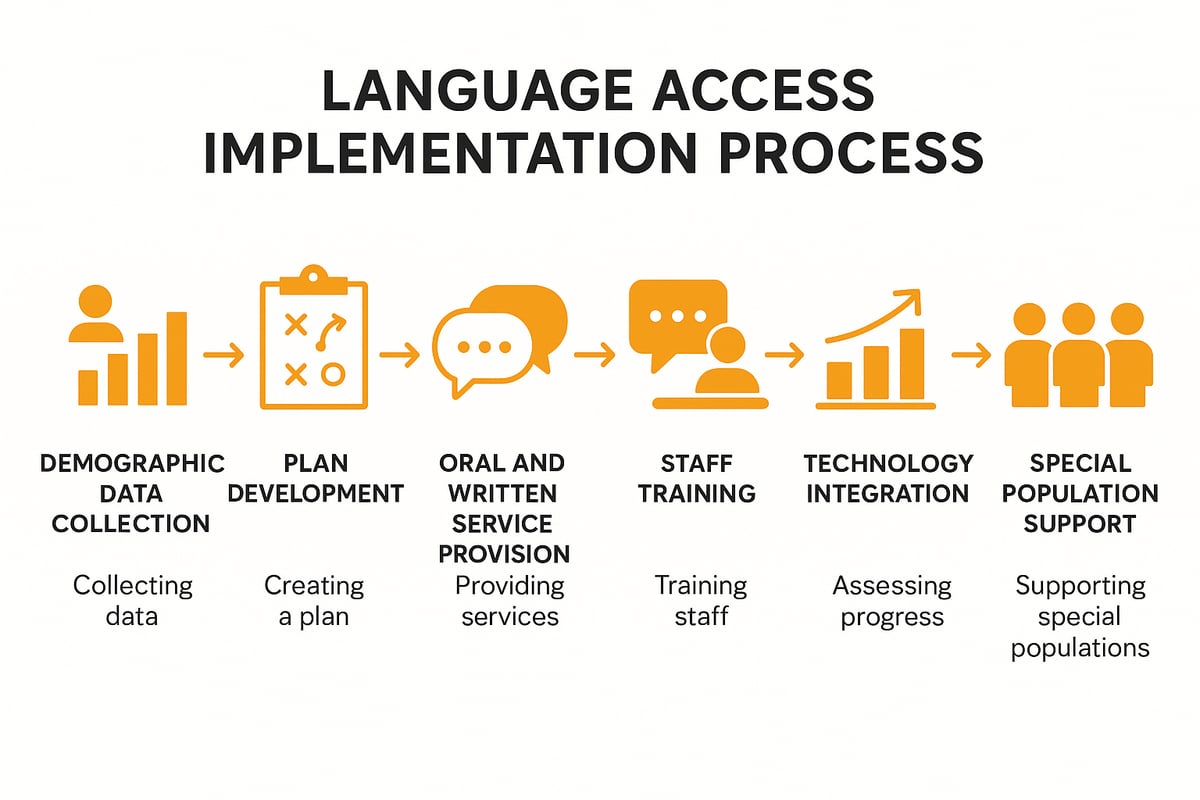
Step 1: Assessing Language Needs
Begin by evaluating the language needs within your service population. Use demographic data from sources such as the Census, American Community Survey, and local surveys to identify the most common languages spoken by Limited English Proficient (LEP) individuals.
Tools like “I Speak” guides make it easier to pinpoint specific needs. Engage local stakeholders, such as community leaders or advocacy groups, to validate your findings and ensure no group is overlooked.
Accurate assessment is the foundation of an effective language access strategy. By understanding your community’s linguistic landscape, you can allocate resources where they are needed most.
Step 2: Developing a Language Access Plan
Once needs are identified, create a comprehensive language access plan. This plan should include a clear policy statement, defined procedures, and assigned responsibilities for implementation.
Set measurable goals and realistic timelines to track progress. Incorporate feedback from LEP community members to ensure the plan addresses real-world barriers.
Reference tools like the DOJ’s planning guide and sample documents for structure. A well-documented language access plan not only supports compliance but also builds trust with the communities you serve.
Step 3: Providing Oral and Written Language Services
Determine which documents are “vital” and require translation to guarantee meaningful access. Offer oral interpretation through various channels, including in-person, telephone, and video remote options.
Prioritize accuracy and clarity in all translations. Ensure staff can provide timely language access services in urgent situations. For instance, Bridging the Language Gap in 911 highlights the impact of effective language solutions in emergency settings.
Delivering both oral and written services promptly helps prevent miscommunication and ensures equitable access for LEP individuals.
Step 4: Training Staff and Building Capacity
Train front-line staff on language access protocols and cultural competency. Training should cover procedures for identifying language needs, using interpretation services, and maintaining confidentiality.
Hiring bilingual or multilingual employees strengthens your team’s capacity. Ongoing professional development ensures staff remain up to date on best practices and legal requirements.
Regular evaluation of staff performance supports continuous improvement, fostering a culture of inclusion and responsiveness in language access efforts.
Step 5: Leveraging Technology for Language Access
Modern technology can greatly enhance language access. AI-powered translation tools, mobile apps, and cloud-based platforms allow real-time communication in multiple languages.
Integrate these solutions into emergency communication systems and service portals. Ensure platforms are accessible, including for individuals with disabilities.
Stay informed about new technologies that can streamline language access, making your organization more agile and effective in meeting community needs.
Step 6: Monitoring, Evaluation, and Continuous Improvement
Establish clear metrics to evaluate the effectiveness of your language access program. Track indicators such as response times, service usage, and user satisfaction.
Solicit regular feedback from LEP users and community partners. Use this data to update your language access plan and adjust strategies as populations and needs evolve.
Transparent reporting to stakeholders and funders demonstrates accountability and supports ongoing program improvement.
Step 7: Addressing Special Populations and Situations
Some populations require tailored language access solutions. Indigenous languages, rare dialects, and crisis situations present unique challenges.
Adopt flexible interpretation services to support emerging needs. Prepare for rapid deployment during emergencies, ensuring all individuals receive timely, clear information.
By proactively addressing these scenarios, organizations can deliver equitable language access, even in complex and rapidly changing environments.
Technology and Innovation in Language Access
Technology is rapidly transforming how organizations approach language access. As we move into 2025, innovation is not just enhancing efficiency but also making services more equitable and reliable for diverse communities.
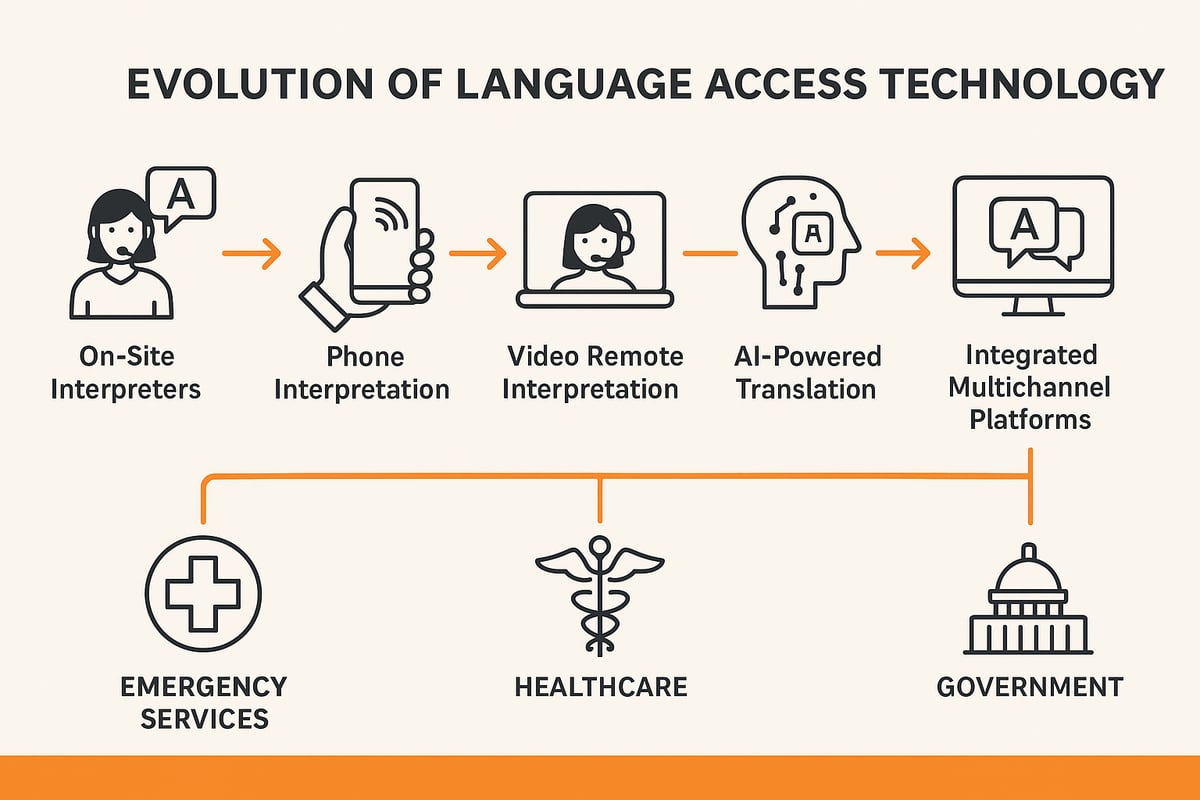
The Rise of AI and Automation
Artificial intelligence is revolutionizing language access by delivering real-time translation and interpretation at scale. AI-powered platforms allow organizations to communicate with LEP individuals faster and more accurately than ever before.
Consider how traditional human interpretation compares to AI-driven solutions:
| Feature | Traditional Interpretation | AI-Powered Solutions |
|---|---|---|
| Speed | Minutes to connect | Seconds for instant access |
| Scalability | Limited by staff | Supports many users at once |
| Cost | Higher ongoing expenses | Lower per-usage costs |
| Availability | Scheduled or on-demand | 24/7, on-demand |
AI is especially impactful in emergency response, healthcare, and public safety. For example, AI Audio Translator for Public Safety demonstrates how real-time AI interpretation can reduce critical delays and improve outcomes for LEP communities. While AI enhances language access, human oversight remains necessary to ensure cultural accuracy and ethical standards.
Multichannel Communication Solutions
Modern language access requires reaching people through several communication channels. Organizations now integrate voice, text, video, and mass notification systems to serve LEP individuals wherever they are.
Key multichannel approaches include:
- Cloud-based platforms for seamless multilingual messaging
- Video remote interpretation for face-to-face interactions
- Text alerts and chatbots in multiple languages
- Accessibility features like large print and Braille for those with additional needs
These solutions enable agencies such as DHS and FEMA to deliver critical information across communities. For first responders and 911 centers, multichannel language access is essential for rapid response and inclusive service.
Data Security and Compliance in Language Technology
As organizations adopt digital tools for language access, data security becomes a top priority. Protecting the privacy and confidentiality of LEP users is not just good practice—it is a compliance requirement.
Best practices for secure language access technology include:
- Using platforms compliant with government standards such as AWS GovCloud or HIPAA
- Encrypting all communications and recordings
- Training staff on secure data handling during interpretation
- Carefully vetting vendors for privacy and compliance
Agency guidelines help ensure that language access initiatives do not compromise sensitive information, building trust with the communities they serve.
Case Study: Emergency Language Access Solutions
Imagine a 911 call center where a caller speaks a rare language. Without immediate interpretation, response times can lag by 5 to 10 minutes, risking public safety.
Recent advances in technology-enabled language access have changed this scenario. By deploying real-time translation tools, call centers have reduced wait times and improved accuracy. After implementing these solutions, agencies report higher LEP engagement and more effective emergency responses.
This case highlights how investing in technology can directly impact outcomes for vulnerable populations.
Future Directions: What to Expect by 2025
Language access technology will continue to evolve rapidly. Key trends to watch include:
- Expansion of AI capabilities and coverage of more languages, including indigenous and rare ones
- Personalized, user-centered design for better accessibility
- Closer collaboration between public agencies and tech providers
- New policy shifts and funding to support innovation
Staying ahead of these trends will help organizations build more resilient and inclusive language access systems for the future.
Best Practices and Resources for Inclusive Language Access
Creating robust and effective language access strategies requires a blend of inclusive policy, staff engagement, practical tools, and an unwavering commitment to continuous improvement. The following best practices ensure organizations can serve all individuals equitably in 2025 and beyond.
Building Inclusive Language Access Policies
Strong language access policies set the foundation for equitable service. Organizations should engage LEP communities in policy development, ensuring all voices are heard. Policies must be clear, actionable, and regularly updated to reflect evolving needs.
Alignment with federal, state, and local requirements is vital. For instance, San Francisco's 2025 Language Access Compliance Report highlights how transparency and accountability in policy drive measurable improvements. Regular reviews and open communication channels help maintain public trust.
Staff Training and Community Engagement
For language access to be effective, staff at all levels must receive comprehensive training. This includes understanding protocols, recognizing language needs, and knowing how to access interpretation or translation services.
Partnering with community organizations and advocates strengthens trust. Hosting listening sessions and feedback forums creates opportunities to learn from LEP individuals directly. Cultural competence should be woven into training, helping staff navigate nuances and build meaningful connections with diverse populations.
Tools and Resources for Practitioners
Equipping practitioners with the right tools is essential for smooth language access operations. Resources like “I Speak” language identification guides, DOJ and DHS self-assessment tools, and online portals such as the MPI Language Portal streamline service delivery.
Sample translated documents, templates, and technical assistance programs further support compliance. Scalable solutions like ConveyConnect Multilingual Interpretation Solutions offer organizations flexibility to meet fluctuating demand for interpretation services across various settings.
Addressing Accessibility Beyond Language
True language access extends to individuals with disabilities. Providing materials in Braille, large print, and alternative formats ensures information reaches all audiences. Digital platforms should meet accessibility standards for websites and mobile apps.
Integrating sign language and communication aids is crucial, as is coordinating with ADA compliance teams. By proactively addressing these needs, organizations remove barriers and create a more inclusive environment for everyone they serve.
Staying Ahead: Continuous Learning and Adaptation
Language access is a dynamic field, requiring ongoing adaptation. Organizations should monitor evolving language trends and changing community needs, participating in professional networks and training opportunities.
Sharing best practices across agencies and leveraging new research ensures strategies remain effective. Preparing for future challenges means updating plans regularly and fostering a culture of resilience and innovation within teams.
Emerging Trends and Strategic Insights for 2025
As the United States moves toward 2025, language access is evolving in response to shifting demographics, new policies, and rapid technological innovation. Organizations, policymakers, and service providers must stay alert to these changes to ensure equitable access for all.
Demographic Shifts and Language Diversity
The American landscape is experiencing unprecedented linguistic diversity. With over 67 million residents speaking a language other than English at home, and more than 25 million classified as Limited English Proficient (LEP), the need for comprehensive language access strategies is clear.
Emerging data from the Detailed Languages Spoken at Home report reveals there are now more than 500 languages spoken nationwide, including a growing number of indigenous and rare languages. These shifts demand that organizations adapt their language access plans to meet increasingly complex needs. Strategic planning based on up-to-date demographic data is essential for effective service delivery.
Policy and Funding Landscape
The policy environment for language access is undergoing significant transformation. New regulatory updates at both federal and state levels are placing greater emphasis on equity and civil rights. The introduction of Executive Order 14224 Overview, which designates English as the official language, is reshaping compliance requirements and prompting organizations to re-examine their language access policies.
Agencies must stay informed about new funding streams and emerging mandates to ensure they can support robust language access initiatives. Collaboration across sectors and proactive engagement with policy changes will be critical for sustained compliance and effective inclusion.
Technology’s Expanding Role
Innovation is rapidly changing the landscape of language access. AI-powered translation and interpretation tools are becoming more accurate, scalable, and user-friendly. These technologies are now being integrated into public safety, healthcare, and education systems, enabling real-time multilingual communication.
However, challenges such as algorithmic bias, accuracy limitations, and ethical considerations remain. Agencies must balance the benefits of automation with the need for culturally competent, human-centered solutions. As technology evolves, ongoing evaluation and responsible adoption will be key for maximizing the impact of language access efforts.
Preparing for the Future: Strategic Recommendations
To stay ahead in 2025, organizations should take a proactive approach to language access. Start with regular needs assessments and update language access plans to reflect changing demographics. Invest in sustainable technology and comprehensive staff training to build long-term capacity.
Forge partnerships with community organizations and technology providers to enhance flexibility and responsiveness. Prioritize rapid adaptation and resilience, ensuring that language access systems can meet both everyday and emergency needs. By embracing these strategic recommendations, organizations will be well-positioned to provide inclusive, equitable services for all.
As we’ve explored, providing effective language access is not just a legal obligation—it’s a crucial step toward building trust, saving lives, and serving every community member with dignity. With the fast-changing landscape and the growing role of technology, you have the opportunity to make a real impact in your organization’s emergency response. If you’re ready to see how seamless, real-time communication can break down language barriers for good, I invite you to Book a Demo and experience how Convey911’s solutions can empower your team for 2025 and beyond.



